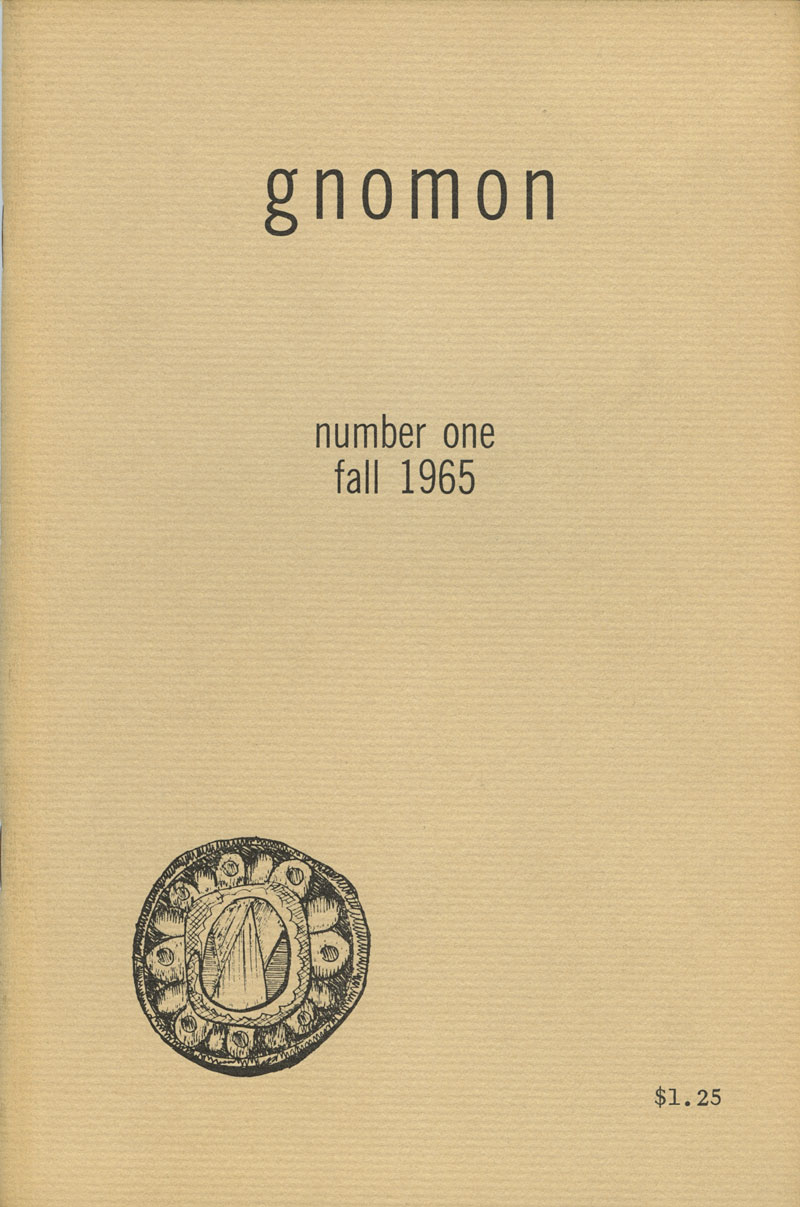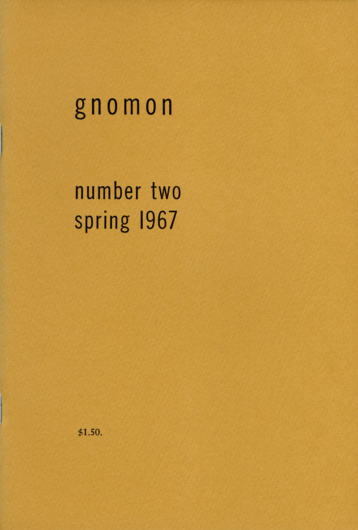Gnomon
Jonathan Greene and Bruce Marcus (1); Jonathan Greene (2)
New York
No. 1 is the “Mediaeval Issue.”
Gnomon 1 (Fall 1965).

No Man Is an Island
The word Gnomon is in the dictionary: it is the hand of the sundial, the pointer. Wider usage includes anything that casts a shadow, as in a skyscraper or a pyramid. But closer to our choice was its kinship in Greek to Gnosis, knowledge, to know and judge … I always imagined No Mon spoken tongue-in-cheek with a calypso accent, since no one knew how to pronounce the word and I would have to encourage those struggling to forget the G was there. There was a Hugh Kenner book of essays, Gnomon, and actually a German magazine with that name. A copy shop in Cambridge, MA, Gnomon Copy, threw a missile across our bow once and said they had patented the word Gnomon and we should stop using it immediately, even though our press existed before they did.
My coeditor, Bruce Marcus, and I met at Bard in 1960. I think he lasted only one semester, but our friendship continued. He was deep into things medieval and texts like Frederick II’s book on falconry. I became a card-carrying member of the Medieval Academy of America and still have back issues of Speculum here. Suddenly we found ourselves writing poems out of this world and knew other texts that would make up a small anthology of such, hence the first issue of Gnomon. For a while I had a rubber stamp which would announce MEDIAEVAL ISSUE on the front cover. Bruce’s sequence on Frederick II fit into our scheme. What a strange intrusion into the mix of what was being published in 1965.
Bruce and Susan then lived on Prince Street off of Thompson in what is now Soho (it wasn’t then). The poet Paul Blackburn lived right around the corner. His ongoing troubadour translation project was legendary, though only a small segment was published early on, by Creeley’s Divers Press. He supposedly had a contract with Macmillan for a larger volume, but that never happened until much later, with another publisher. Paul gave us a large selection of his versions of Marcabru, almost all his versions that did not appear in Angel Flores’s Modern Library An Anthology of Medieval Lyrics.
I was well aware of my lack of design/printing know-how. Some printer I guess Bruce knew gave us masters and my first wife typed the magazine up into those and the printer reduced it all and printed it. I have spent my life making up for the poor design of this first publication. Bruce and I had no stable address, so his folks’ address was used. The device on the cover and contents page was by my friend Manus Pinkwater, who became a children’s book writer known after his first book as Daniel Pinkwater.
Then we got Joan Ferrante to translate two sections of Alain de Lille’s Complaint of Nature in a version superior to any other I’ve seen in English. And a mystery no one has ever commented on: the version we published of Arnaut Daniel’s L’aura amara with alchemical commentary by someone hiding behind the pen name of Imal Ibn-Lami was actually by the poet David Rattray (1946–1993). As far as I know, this was never reprinted and no one knows of this translation, relying instead on Pound’s ancient versions of Arnaut. Charles Williams (with Tolkien, C. S. Lewis, and others) was one of the Inklings and Bruce and I were both reading him at the time. Part of a Charles Williams text on his Arthurian poems was published in Williams’s The Image of the City, but ours was the first publication of the complete text.

Gnomon 2 (Spring 1967).
Before the second issue of the magazine came out, Bruce Marcus had dropped out of Gnomon and I had published two books (Fragments of a Disorderd Devotion by Robert Duncan and Charles Stein’s first book, Provisional Measures). I was starting to get a handle on book design and production. Both the second issue of the magazine and Chuck’s book were printed by Graham Mackintosh in San Francisco. He helped further my education in the world of printing and typography.
The second issue opened with a translation of an ancient Egyptian poem—R. W. Odlin had a knowledge of Egyptian and Guy Davenport fashioned the final language. They were supposed to do three of these and I promised to publish them as a chapbook. They never followed up. Odlin penned the glyphs and they stretched out for yards. I left this with Graham and do not know their fate.
This issue was more in the mainstream of contemporary poetry, with poems by Ted Enslin, Robert Kelly, and Robin Blaser, and reworkings of classical texts by Charles Stein and Harvey Bialy. I asked a scholar in Berkeley to translate an essay by Jorge Luis Borges that I don’t think appeared again in English until the big volume translated by Eliot Weinberger years later. I did an offprint for the translator that is scarce, though I still have most of the sheets for it. Pound’s two pages of gists he garnered from Richard of St. Victor I think were previously published in Italy and Germany but not in the States. In any case James Laughlin credited Gnomon in Pound’s Selected Prose, 1909–1965 (pp. 71–72) published by New Directions. The longer translation from Richard of St. Victor was not by Pound and should have been attributed to S. V. Yankowski.
Though Laughlin kindly gave credit to Gnomon for the Pound, the magazine was mostly a stealth publication in other regards: the eleven pages of Blackburn’s Marcabru were never credited when Paul’s full Proensa appeared, nor were the poems of Blaser or Enslin that appeared in Gnomon credited when they were later published in their books.
The import such a magazine might have had in the swift-flowing stream of literature is unknown.
— Jonathan Greene, Franklin County, KY, April, 2017
